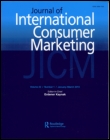
Aichner (2014) proposes a classification of ways in which brands communicate their country of origin (COO). The current, exploratory study is the first to empirically investigate the frequency with which brands employ such COO markers in magazine advertisements. An analysis of about 750 ads from the British, Dutch, and Spanish editions of Cosmopolitan showed that the prototypical ‘made in’ marker was rarely used, and that ‘COO embedded in company name’ and ‘use of COO language’ were most frequently employed. In all, 36% of the total number of ads contained at least one COO marker, underlining the importance of the COO construct.


 Brands can position themselves as belonging to a foreign culture by using foreign languages in advertising. Foreign languages in ads have been suggested to be implicit country-of-origin (COO) cues. This paper examines the expectations that foreign languages operate through the COO effect (Study 1), and that they evoke associations (Study 2) and generate persuasive effects (Study 3) similar to COO mentions. The findings of the studies, employing different language slogans for different products, lend support to these expectations. Thus, foreign languages in advertising derive their effectiveness from the COO effect, and practitioners can use them to benefit from this effect.
Brands can position themselves as belonging to a foreign culture by using foreign languages in advertising. Foreign languages in ads have been suggested to be implicit country-of-origin (COO) cues. This paper examines the expectations that foreign languages operate through the COO effect (Study 1), and that they evoke associations (Study 2) and generate persuasive effects (Study 3) similar to COO mentions. The findings of the studies, employing different language slogans for different products, lend support to these expectations. Thus, foreign languages in advertising derive their effectiveness from the COO effect, and practitioners can use them to benefit from this effect.